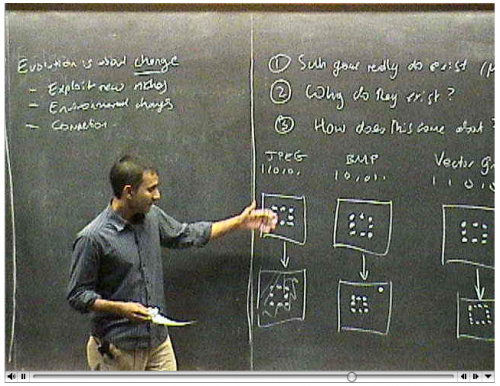The evolution of evolution: amazing matchups between the code and the coded
But what really distinguishes this meeting from a typical conference is that there are only between one and three (mostly two) talks per day! For the rest of their time at the meeting, the ninety-odd participants interact. “KITP meetings are more about what happens outside of the talks”, says Mukund. “It's about staying at one place and working with people. When we arrive we are each given an office with a desk. Mine has a view of the sea, which is just 20 yards away. The weather is beautiful, people are relaxed... and we do science.”
Mukund was a very appropriate choice as one of the three meeting organisors, since much of his research is focused on what bacteria can tell us about evolutionary mechanisms. In one of his most recent papers Mukund and his co-authors suggested a significantly new way of thinking about an intriguing feature called collinearity, in terms of the evolution of evolution itself.
Collinearity, a phenomenom so unexpected that Mukund calls it “shocking", is most easily explained by describing the bacteria-based system Mukund examined in his paper. There are three components to the system: first, a linear polymer built from a number of different components, second a linear "mega-enzyme" that is composed of enzymes that each manufacture one of the polymer components, and lastly a set of genes each of which codes one of the enzymes. Remarkably the sequence of the genes on their chromosome is the same as (i.e. collinear with) the sequences of both the encoded enzymes and the respective polymer components. From the individual bacterium's point of view this match-up provides absolutely no benefit at all: the various enzymes could “work out” how to get together in the right sequence irrespective of the sequence of their respective genes on the chromosome (and experimentally, they do) or even if the genes were not on the same chromosome at all.
Examples of collinearity are found throughout the phyla, and the most famous example, involving the Hox genes and body-plan establishment in animals as diverse as flies and mammals, has played a huge part in our own evolution. So why does collinearity occur? We are all familiar with the idea that life evolves, but there is also selection pressure on the processes that underpin evolution. Evolution depends on mechanisms that permit generational genetic change, such as sexual gene mixing and inheritance of mutations. Such mechanisms are likely to be maintained and perhaps “improved” in the long-term because the environments that organisms exist in are very dynamic – life can never afford to take a rest!
The selection pressure that temperamental environmnents place on the sources of genetic variation is beautifully illustrated by those life-forms, such as aphids, anemones and many plants, that can switch between asexual and sexual modes of reproduction. When times are good these organisms exploit the explosive potential of asexual reproduction, but when resources are limiting or the environment harsh they deprioritise quantity in favour of quality, and look to the possibly useful variations served up by the chromosomal recombinations of sex.
In Mukund's paper the authors used computational modelling to telescope millions of years of (simplified) evolution of their mega-enzyme into time-scales suitable to experimental observation. The results suggested that, while collinearity might render no benefit to the individual, it could lead to more efficient evolution. Collinearity could help to make sure that when genes get shuffled in any form of recombination process (whether it be sexual or the non-sexual horizontal gene transfer common to bacteria) the genes that encode for proteins that work together are more likely to remain together. And thus recombination can deliver innovation without dispensing with all the hard-won gains of previous evolutionary adaptations. Collinearity provides a ratchet.
In his keynote talk at the KITP meet - one of the famous Blackboard Lunches of KTP - Mukund gives a very lucid and entertaining explanation of collinearity and many other aspects of evolutionary genetics. You can view his talk at KITP here.
Mukund and fellow NCBSians, Satyajit and Madan, have been inspired by the productivity that results from the meeting's novel structure, and plan to start a program at NCBS along similar lines. “We would get people to visit NCBS for maybe 3-6 months”, says Mukund, “and just drive everyone to think about a focussed set of problems.”


Comments
Life in Math... Mukund rocks
it would be interesting to
Post new comment